Small baggage for plenty of surround
Andrew Levine had several opportunities of working with the Charities Philharmonia under the leadership of Michael Young over the last few years. This young symphony orchestra, characterized by it's enthusiastic music making, organizes two concerts a year, the profits of which go to a charity of their choosing.
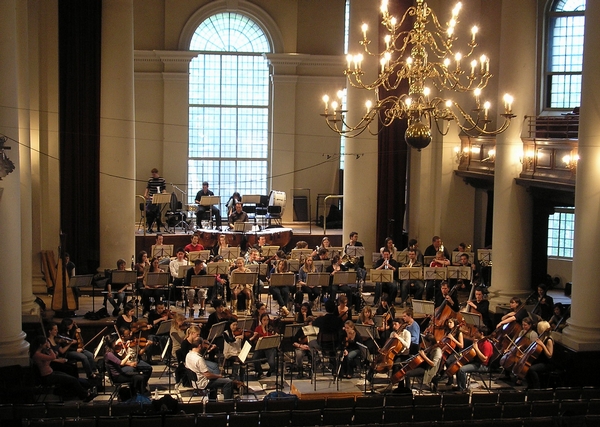
The performance space has nearly always been the former church St. John's Smith Square in central London, a building erected 1728 in the English Baroque style, which features among other things a very pleasant acoustic. As always Andrew planned not only for a stereo but also a 5.1 surround mix. This is a report on his interesting activities which convincingly demonstrates that is possible to realize outstanding surround recordings of live events.
The preparations
As a main microphone Andrew had previously employed either an AB- (with a spaced pair of omnis at 51.5 cm distance) or an ORTF-pair of cardioids. The current program featured Mahler's fifth symphony, devised for an especially large orchestra, which is why he decided to use an AB-pair close to the ensemble that would extend quite far to the back. The microphones selected are two Earthworks QTC-50's.
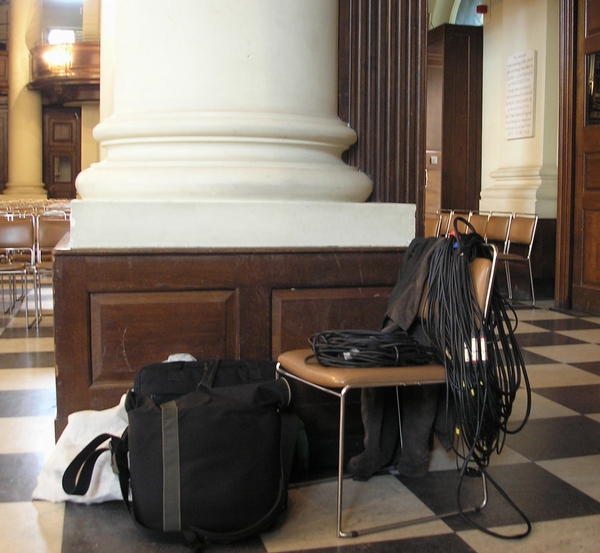
Additionally he always uses a pair of DPA 4060's as ambient outriggers in the tier above the audience. For the first concert the capsules had been mounted as boundary layer microphones on the far sides of the columns flanking the orchestra, subsequently higher up and above a lateral passage in the first third of the hall.
The issue was that the imaging of these microphones (when placed lower and on the columns) turned out to be too direct, possibly because of reflections from the close walls; the tracks had to be processed with AltiVerb. The new improved location made this step obsolete.
From the beginning Andrew also used two ribbons, the RoyerLabs SF-1's, flanking the conductor, facing sideways and angled 30 to 45 degrees downward. These spots cover the first violins and usually also the first stand of the second violins as well as the cellos. Two additional spots used for this last recording were: (1) a UM-1 (the prototype of a large diaphragm condenser with switchable characteristics by United Minorities) in fig-8 configuration in front of the woodwinds and (2) an Elation KM-201 with omnidirectional capsule pointing at the bridge of the lead string bass. The micpre and ADC used has always been Metric Halo's ULN-8 and an Ultrasone PROline 750 headphone was used for monitoring.
Since Andrew maintains a small cache of microphone stands and cables in London his carry-along was minimized: a large bag with all microphones and the laptop as well as a large backpack holding the ULN-8, AB-bar and a low mic stand, additional mic cables, the adapter for british wall sockets and all shock mounts. Still it is preferable to not fly with a budget airline ...
The setup
"I always travel the day before big recordings. In this case I arrived in London on Friday afternoon and could inspect all gear and configure the MIO-Console in the evening. The setup began on Saturday at 11 AM, three hours before the rehearsal."
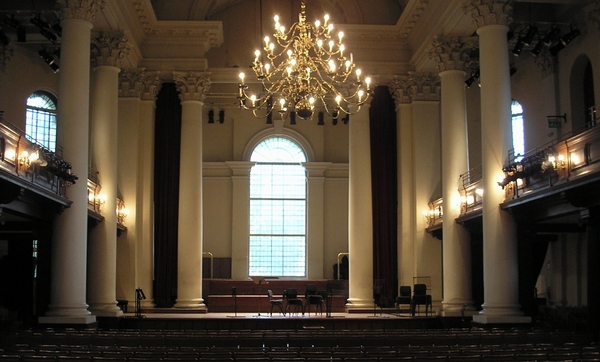
"The chairs for the musicians were not set up yet, so I first prepared the four microphone stands (2 x standard, 1 x with boom and 1 low stand) with shock mounts and then went to the upper tier. Flying microphones is generally more labor intensive than setting up stands, and the configuration is usually not easily modified on the fly, but required at St. John's as well as many other venues for all positions besides the stage area.
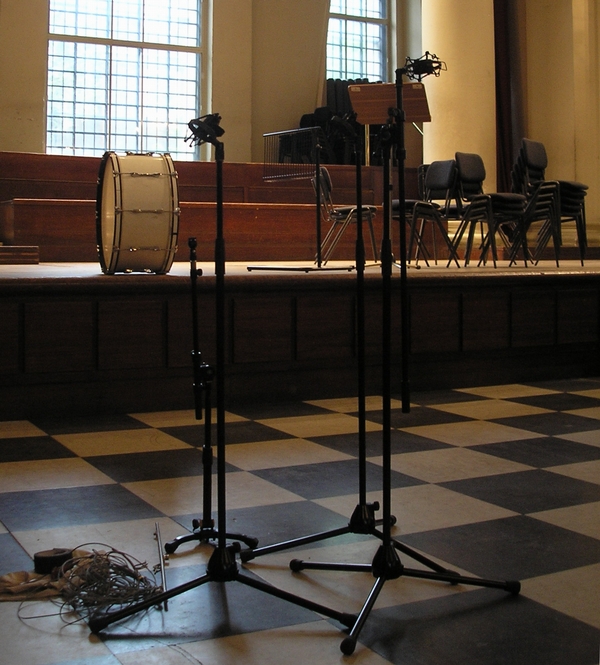
The podium for the conductor was positioned and the chairs for the orchestra were being set up. When working without an assistant it is good to spend some time reflecting on the logistics of one's setup. I attached a nylon line on the upper tier opposite the one accessible staircase and placed the right hand side ambience mic. Then I crossed back and attached a strong wire and the special microphone cable for the DPA 4060. A helper knotted first one, then the other to the nylon thread and I could quickly finish on the right hand side: a sturdy suspension for the AB-pair and the connect for that side's ambience pickup. The nylon thread was then attached to the AB-bar for easy positioning from below.
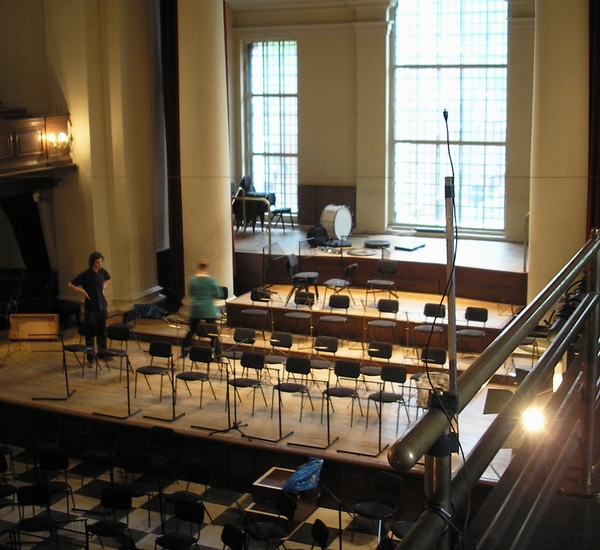
Next I attached the two Earthworks-microphones and the left hand side ambience capsule and dropped four XLR-leads down to my position, behind a column on the left hand side of the orchestra. The interface was switched on and the first and most important four microphones powered and checked. It is essential to check every channel meter-wise and by ear as soon as the mic is connected. The AB-bar was then positioned correctly and held in place by fixing the nylon thread to the rails at the opposite side.
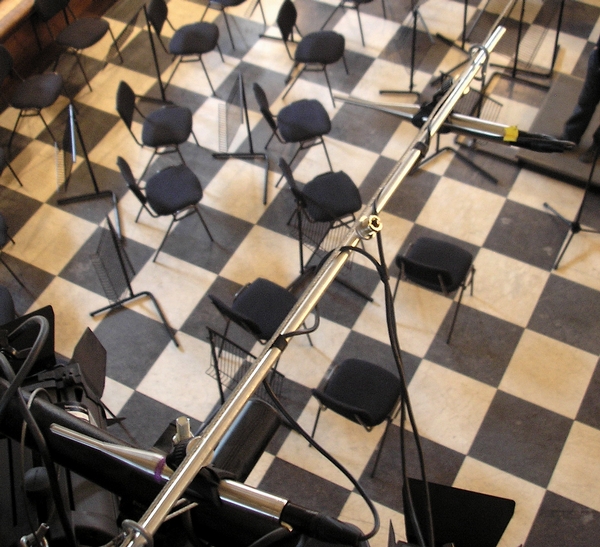
So far everything had gone smooth, the chairs for all strings had been placed and I now positioned the flanking ribbons, facing downwards and 45 degrees left and right towards violins and cellos. When checking these channels I had only noise on one of them. It could have been the microphone, the mic cable, the db-25 connector to my interface or even a configuration issue. Moving the cable to a working input moved the noise, which eliminated all but the first two causes. Luckily a cable swap solved the problem. Even when planning for minimal baggage some redundancy can save the day.

Now there were only the two spots for woodwinds and one of the basses left. Setup and checking went smooth and I now had only to wait for the arrival of all musicians.
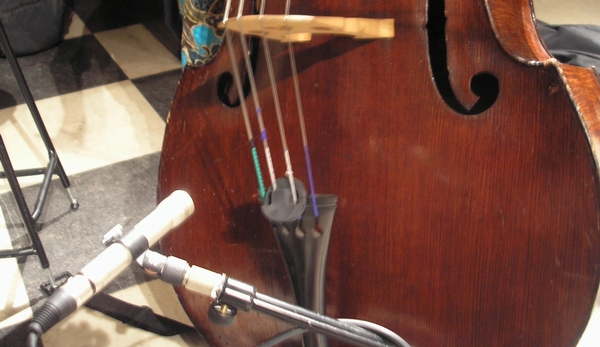
For this concert the orchestra was streched very far from front to back, since the stage had not been extended as usual. My main microphone was positioned over the back edge of the conductor's podium and quite a bit higher than is my custom; about at the height of the percussion and tympany on the upper raiser. This can cause a problem with regards to a decreased sense of depth, but since the large body of the orchestra was not set up to maximize it's compactness I felt it was a workable compromise.
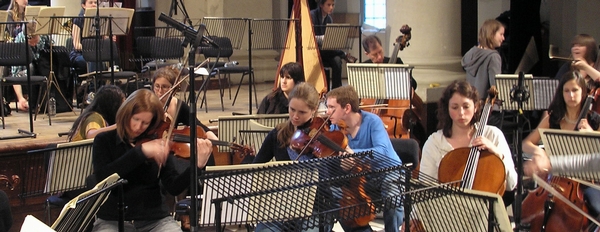
I might have moved the main microphone down by a half or even one meter, but like I said before such a modification is less easily accomplished with a flying setup--and then the conductor had asked me to track the entire of the rehearsal to have material for potential edits. I am happy to say that on subsequently reviewing the material in my studio the sense of depth is nicely conveyed. For sufe, the number of strings could have been larger. Woodwinds and brass as well as the percussion and tympany are spaced well, and even the triangle does not stick out." says Andrew regarding his setup.
The rehearsal
At 2 PM the orchestra was complete and Andrew could set approximate levels during the turmoil before the tuning. The requirement to capture the entire rehearsal in a way that makes all material usable for potential fixes influences the amount and degree of changes to gain- and pan-settings as well as the live mix. Andrew had created a monitor mix on an auxiliary path to be able to check potential modifications before applying them to the live mix that was tracked in addition to all live inputs. Fortunately few and slight changes (to gain and pan) were required only at the beginning of the rehearsal.
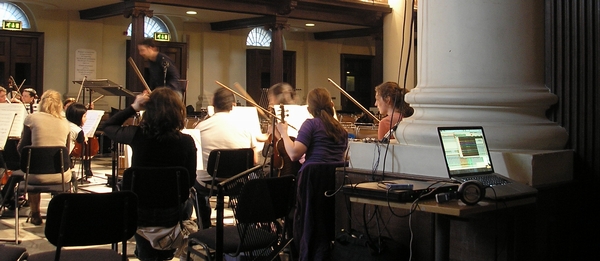
Regarding his recordings Andrew states that "I start out by guessing at the delays between microphones because their position has usually not been finalized. This approach proved effective a little into the rehearsal when the conductor decided to move all woodwinds from right to left and the trumpets from left to right--which certainly made a lot of sense. So much for the original idea of guaranteeing complete coverage and usability of the entire program material.

Another surprise was when a horn player was positioned in front and left of the orchestra for the third movement of Mahler's fifth symhony. This sounded very nice, but the first violins moved aside and back which made it imperative to correct the placement of the left flanking microphone. But that's live, and in any case the show must go on ...
After the rehearsal I marked every mic stand's position with gaffer and measured all delays between microphones using two claves to optimize the live-mix of the concert."
Interlude
As far as effects (besides the sample delays) are concerned Andrew used a high-pass on the ambience microphones and the woodwind-spot, some 2nd-character (valve saturation on the ambience pair and transformer "metal" on the sum) as well as a final limiter (+4.5dB and a cut-off at -0.3 dBFS).
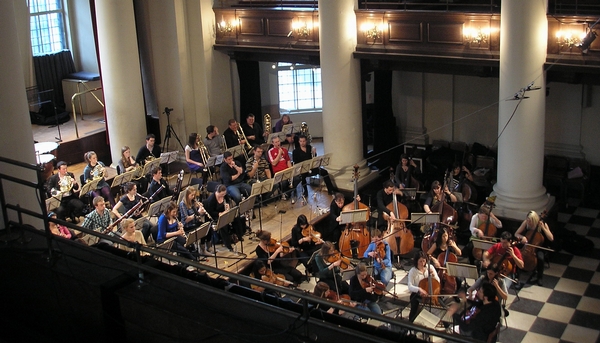
As Andrew stated: "during a small break before the concert I had the chance to reflect on my settings. I corrected the limiter to +3 dB because most ensembles perform a bit more energetic during the concert, and I bypassed the high-pass on the woodwind-spot. The frequency curve of a large diaphragm bidirectional (fig-8) capsule naturally exhibits an early dropoff and I had positioned that microphone with the vertival zero-degree-axis facing towards the brass and percussion.
The last thing on my to-do-list was a close inspection of the conductor's podium that now consisted of two stacked boxes. And I did find the source of a slight ringing I had hear at one point: two metal wheels that could turn when agitated. Some gaffer stabilized them just in case."
The concert
"I raise the gain of the woodwind-spot during the orchestra's tuning. Having delayed it by the the exact amount (after my measurement) has resulted in it's tighter integration and I can increase intelligibility slightly. I also decide to track the concert at 88.2 kHz. For the rehearsal I had used 44.1, but after having backed up all those tracks there is plenty of room--and you never know.
There was one final surprise: When cranking up headphone gain I heard a very slight hum before the Rachmaninov that had been inaudible before. In the susequent break I went up to the top tier where I found the door from the staircase--with the heating system--staning open to the concert hall. There was also a video camera positioned right next to my left ambient pickup. Luckily it was no problem for the vidiographer to position himself father away, biut I'll nevertheless have to inspect this track closely for any noise.
The concert went well. While the overall performance of the orchestra with such a complex repertoire definitely could have been improved with more than the two tutti rehearsals, and while there had been a few last-minute dropouts, spefically within the string section, the logistics of assembling and working with such a large ensemble that meets twice anually for a pro-bono performance is far from trivial. In any case I was once again able to provide the Charities Philharmonia with a very high quality recording, and I again enjoyed a fine weekend in London." So much for Andrew's interesting report.
About Andrew Levine
Andrew Levine was born 1968 in NY city but quickly moved to Frankfurt am Main. As sun of a trumpet player he got into music at an early age, studying violin and singing, then detoured into pursuing an academic career. He received an M.A. in compu- tational linguistics and cognitive psychology at the University of Trier and moved to Berlin in 1995, where he was busy as MultiMedia specialist on Apple‘s promotion tours and lectured university graduates in the fields of software development (lots of Java) and A/V media. Besides this occupation he developed multimedial CD-ROM's and shot and edited several documentaries in the field of pedagogics.
At some point around 2002 the music reemerged and „sound“ became central to Andrew's life. There followed intensive studies of the theory of recording and lots of ears-on experimentation with various musicians, tracking whatever he could lay microphones on: Organ recitals, choral concerts, tango sextets, live rock and oratorios. In 2004 Andrew released the 1st CD of his sonophile label „blumlein records“ (LC 13941). In the following year he was excepted into the German Tonmeister association (VDT) and moved to Hamburg with his studio and family.

Early in 2008, after recording many a concert within the quadraphonic paradigm in preparation for enveloping remixes Andrew‘s studio is finally upgraded to support 5.1 surround with a setup custom built by United Minorities. Several months are spent experimenting with surrounding renditions of sessions dating back to 2003. In the same year Andrew develops and tests the XYtri that is presented at the bi-annual VDT international convention. Other developments include „psMsp“ (Parallel Spaced MS- Pairs) that are also employed for experiments with surround plus height channels, and the very recent „4x8“ approach to quadraphonic miking.
 How to resolve AdBlock issue?
How to resolve AdBlock issue? 